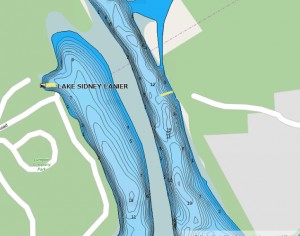As carp anglers, we are always looking for that little bit of extra knowledge that will get us more fish on the bank. Tons of effort has been spent on making a better bait or rig, and lots of excellent information is available on choosing the best spot to cast your baited hook. This is all, of course useful…but only to the point of getting the most out of the swim. The key thing is location, because if no carp are in the area to find your bait all the rest is really pointless.

While relatively little is known about the movements of carp, a few researchers have studied carp with radio tracking implants and have been able to shed some light on where exactly the carp are at a given time of year and how they move around.
At first glance carp might seem to be a rather sedentary fish, but this is not always the case – especially in rivers. For example, some tagged carp in the Murray River in Australia were found to move up to 890km (553mi), with a number of fish moving at least 100km. While the majority of carp did not move this distance (most moved no more than 5km), a movement a fraction of this can easily put fish in an area that is well away from your swim.
One of the more interesting bits of information gleaned from carp radio tagging is the amount of variability found between individuals. As anglers we may have noticed that all carp don’t behave the same way, with some fish having a preference for a certain bait, or maybe that you never catch this one carp in the same place twice? This same phenomenon was found in the fish that were tracked, with some fish doing things very different than others for no known reason. While this may seem like a case of why bother, there is some good news for carp anglers: females and larger males move less than smaller males. In other words, the fish we want to catch move less, so once you find them they will likely stay in the general area.

Naturally, over the course of the year how much carp move differs, with less movement during the winter. Movements start to get into full swing when water temps get around 13°C in the spring as fish start to get ready for spawning (with spawning happening in water temps between ~18 and ~23°C) by moving into areas near shallow flats with submerged vegetation and woody debris . Right after spawning, carp spread out and can be found in more locations. Once temperatures fall to near freezing there is a rapid movement to the over-wintering location. Once in this location there is very little movement until the following spring. This schooling is most pronounced in areas that get really cold with temperatures of only a few degrees above freezing tending to produce the largest schools. Where these schools form can be very predictable from year to year, so if you find fish one year they will likely be there the next.
If they are to be found in the water you are fishing, a key factor to locating carp are weeds beds. During all seasons it has been noted that carp strongly prefer to be near some sort of vegetation. This is not really surprising as most of the carps’ natural food is found in these areas. After vegetation, the next most utilized habitat type is silt, again where a number of different food items are to be found. Sandy areas are not used as much by carp in a natural setting. Even during the winter the carp don’t prefer the deepest areas. There is a general trend of increasing distance to shore and water depth during the winter but vegetated areas are still preferred if available.
Okay, so how does this help? Well that is up to individual interpretation. What I see is this: carp like vegetation and shallower water. There are a few obvious reasons for why this is the case and they include food and cover. But what about in locations where there is little vegetation to be found such as large reservoirs? In these lakes most of a carps food will be from soft silt where there will be blood worms and clams. I would also conjecture that carp can also be found over rock areas as they forage for crayfish, but at this time I have not found any research looking at this.
One thing thats keeps coming up is “shallow water”. How shallow is shallow? While not mentioned in any of the works I have read I think that the fact that carp tend not to use the deepest water available is likely linked to where their food is likely to be found. Since carp primarily eat aquatic invertebrates which are largely unable to move with changing condition these organisms need to be in areas that have enough oxygen to support them, in deeper lakes this is above the thermocline. The thermocline is a rapid change in water temp that keeps the surface water (with lots of oxygen) from mixing with the colder deeper water (oxygen poor). How deep the thermocline is will vary with the a number of factors, but in general the clearer the water the deeper the thermocline will be. A simple way to learn how deep the thermocline is is just call your local fisheries management agency that works on the lake you are interested in – they should be able to tell you. I will post more about the thermocline in another article.

I hope this will help when you are trying to decide where to fish and give you a better understanding of where the fish will be.

